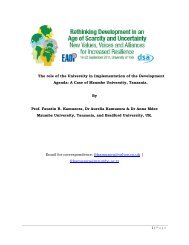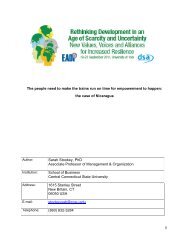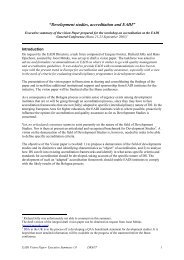Revenue Administration in Sub-Saharan Africa - International Tax ...
Revenue Administration in Sub-Saharan Africa - International Tax ...
Revenue Administration in Sub-Saharan Africa - International Tax ...
Create successful ePaper yourself
Turn your PDF publications into a flip-book with our unique Google optimized e-Paper software.
Institutional arrangements for revenue adm<strong>in</strong>istrationChapter IKey f<strong>in</strong>d<strong>in</strong>gsInstitutional arrangementsIn 13 countries, revenue adm<strong>in</strong>istration is the responsibility of a unified semiautonomousrevenue body.• Eleven of the 13 unified semi-autonomous revenue bodies have a governancestructure that <strong>in</strong>cludes an oversight board of directors.• Two unified semi-autonomous revenue bodies are more autonomous as theirgovernance structures provide for advisory committees which do not haveoversight responsibilities.• In 2 countries, revenue adm<strong>in</strong>istration is the responsibility of a s<strong>in</strong>gle revenueadm<strong>in</strong>istration directorate with<strong>in</strong> the M<strong>in</strong>istry of F<strong>in</strong>ance (MOF).Scope of responsibility• All the 13 unified semi-autonomous revenue bodies adm<strong>in</strong>ister both tax andcustoms.• <strong>Revenue</strong> bodies also adm<strong>in</strong>ister a number of non-tax revenues, the mostcommon be<strong>in</strong>g motor vehicle fees.• Three revenue bodies have (to some extent), or are <strong>in</strong> the early stages of<strong>in</strong>tegrat<strong>in</strong>g the collection of social security contributions with tax operations.Autonomy of revenue bodies• All revenue bodies <strong>in</strong>dicated that they have sufficient powers to <strong>in</strong>terpret taxlaws and issue b<strong>in</strong>d<strong>in</strong>g or non-b<strong>in</strong>d<strong>in</strong>g public and private rul<strong>in</strong>g of how taxlaws will be <strong>in</strong>terpreted.Delegation of authority• The majority of revenue bodies are of the op<strong>in</strong>ion that they are fully <strong>in</strong>volved<strong>in</strong>, and contribute towards the mak<strong>in</strong>g of tax laws <strong>in</strong> their respective countries.• All revenue bodies <strong>in</strong>dicated that they have powers to remit adm<strong>in</strong>istrativepenalties and charges.• Majority of revenue bodies have powers to allocate budgets <strong>in</strong>ternally,<strong>in</strong>dependently design <strong>in</strong>ternal structures, fix levels and mix of staff, hire anddismiss staff, set performance levels and negotiate salary with staff.Internal governance structure• All revenue bodies have an <strong>in</strong>ternal audit department and are also subject toreview by external public and/or private auditors.<strong>Tax</strong> payers’ rights and compla<strong>in</strong>ts handl<strong>in</strong>g• In the majority of revenue bodies, taxpayers’ rights are enshr<strong>in</strong>ed <strong>in</strong>adm<strong>in</strong>istrative documents.• All revenue bodies, except Burundi, have <strong>in</strong>ternal structures for receiv<strong>in</strong>g andaddress<strong>in</strong>g compla<strong>in</strong>ts from taxpayers.8





